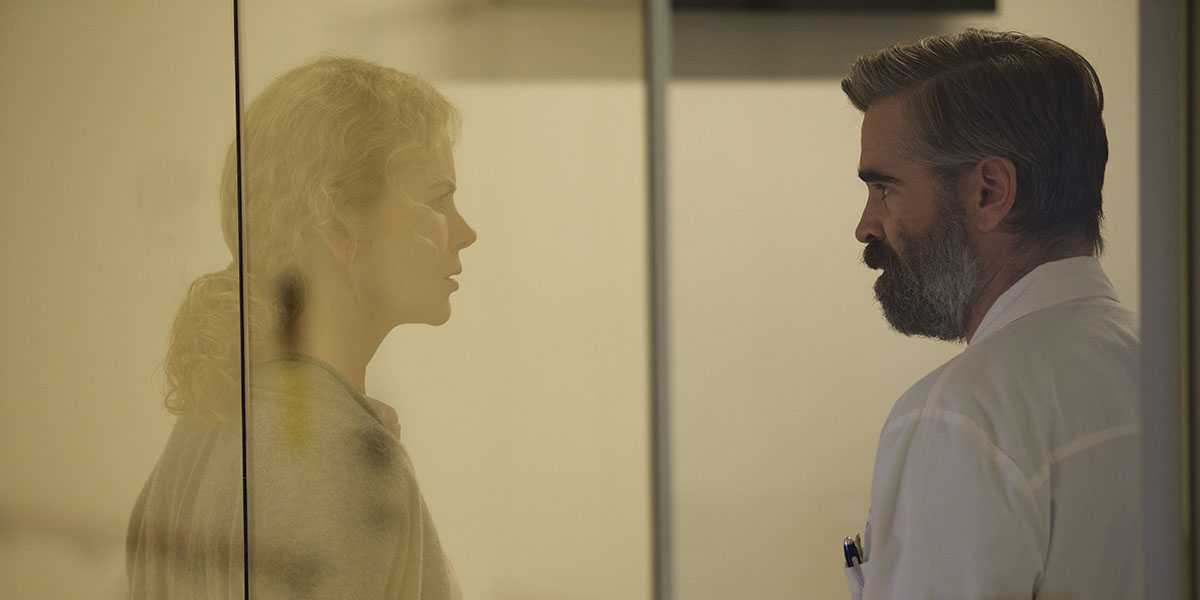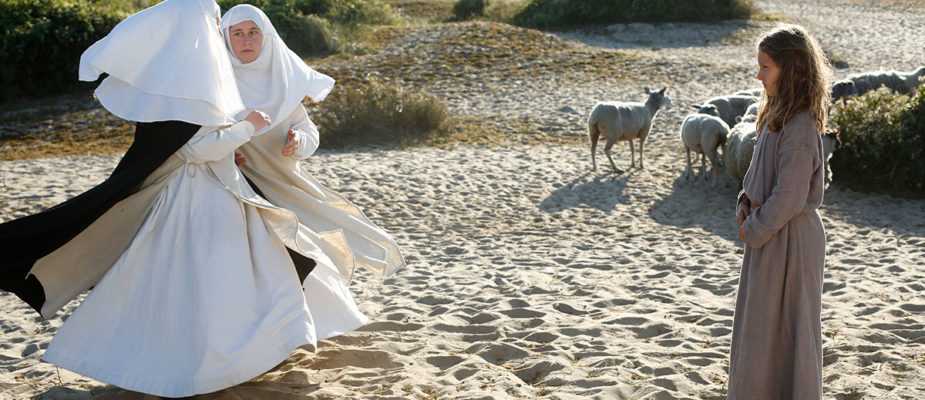It’s the middle of summer, 1425, and on a sandy stretch of land beneath the Bleu de France sky, a young Joan of Arc wrestles with her vocation–and her country’s fate–amidst a never ending, off-screen war with the English. Written and directed by Bruno Dumont, mid-career maestro of Li’l Quinquin (2014) and Slack Bay (2016), which both successfully played the Noble Theater, Jeannette, the Childhood of Joan of Arc approaches its iconic French subject, Joan of Arc or Jeannette, from the less common perspective of her girlhood, spanning the adolescent years before she acts on her call and rises to heroism, and eventually martyrdom, during the Hundred Years’ War.
Far less common still is Dumont’s amateur, middle-school musical pageant approach to his source material–material that draws on two turn-of-the-twentieth-century works by French writer Charles Péguy. Jeannette, her close friend Hauviette, spiritual counsellor Madame Gervaise (eccentrically played by a pair of twin nuns), and her young uncle, vocally engage in dense theological speculation, prayer, and ruminate about their country’s fate, all the while adopting a range of musical forms (and accompanying off-kilter dance gestures) that tend to favor electronic backing and punk-metal affectation (or Jeannette’s uncle’s remedial French white rap). The effect that emerges, immediately, is one of cultivated dissonance, where elements of form and content play against one another, where children loquaciously consider the condition of life during endless war, and the role of the divine in adjudicating their nation’s future.
Yet is also a work in which Dumont grants his young actresses and actor qualities appropriate to their age, where Jeannette will spin off into a sudden cartwheel, or where teenage Hauviette will cross the Northern French landscape arched over like a crab. There is, in other words, an almost indexical or non-fictional feeling of the film’s actors’ mannerisms, and their childlike gestures that would seem to belie the film’s alternative seriousness of purpose.
On the other end of things, Dumont’s film seems to play out, especially in its extended theological soliloquies, like the isomorphic, open-air materialist theater of Jean-Marie Straub and Danièle Huillet (cf. Moses and Aaron, 1974; These Encounters of Theirs, 2006), emphasizing the materiality of Jeannette’s young corporeal existence–the sudden presence of angels hovering over a river bed, or the duplicate Gervaises, notwithstanding.
Place is likewise essential, though perhaps as much for its descriptive connotations for the film’s production than for anything related to the narrative per se. The shepherdess Jeannette, for most of the film’s first two-thirds or so, does not leave the same one or two locations where she grazes her flock (animals, it should be added, that show a further inclination to disrupt the film’s more serious moments). As the film unfolds, this unity of setting becomes something of a joke, even comically appearing in the film’s on-screen titles that note that we are still in the same place, time and again. Of course, they also confirm the film’s extreme budgetary limitations, and one would have to assume its short production schedule, confirming that Dumont’s is a film tossed off rather quickly (in the very best of senses).
Ultimately, Jeannette, the Childhood of Joan of Arc extends the program of the director’s past few features, producing a world once again that is in many senses a study of contrasts and opposites. Dumont’s musical is deliriously, almost perfectly off key, and stands as a worthy addition to one of contemporary France’s invigoratingly idiosyncratic bodies of work.
 Possessed of the spirit of Stanley Kubrick, from its predilection for wide-angle shots, forced perspective, and Steadicam set-ups to the presence of Nicole Kidman (giving at least the whiff of Eyes Wide Shut), and a dissonant metallic soundtrack, Cannes competition Best Screenplay winner, The Killing of a Sacred Deer, finds Greek director Yorgos Lanthimos taking a step forward from The Lobster (2015), crafting a world in which the mechanisms of fate and story become indistinguishable, as Colin Ferrell’s cardiac surgeon is forced to repay an old debt. Farrell’s Dr. Steven Murphy has struck up an unusual paternal friendship, made all the more so by Ferrell’s mannerist-autistic acting style (a style long favored by the Dogtooth director). We learn that the troubled Martin, the 16 year-old object of Murphy’s mentorship, lost his father on Ferrell’s operating table a few years earlier, an event that will become decisive for The Killing of a Sacred Deer’s internal sense of justice. Meeting at first in secret, Dr. Murphy eventually introduces Martin to his wife (Kidman) and two children, with his teenage daughter quickly developing a heated crush on their bizarre visitor. Martin in turn attempts to set the doctor up with his widowed mother (Alicia Silverstone), before revealing his ultimatum for the physician–one again that is as much a product of the film’s story trajectory, of its classical, Old Testament moral structure, as it is internal to the film’s interpersonal drama.
Possessed of the spirit of Stanley Kubrick, from its predilection for wide-angle shots, forced perspective, and Steadicam set-ups to the presence of Nicole Kidman (giving at least the whiff of Eyes Wide Shut), and a dissonant metallic soundtrack, Cannes competition Best Screenplay winner, The Killing of a Sacred Deer, finds Greek director Yorgos Lanthimos taking a step forward from The Lobster (2015), crafting a world in which the mechanisms of fate and story become indistinguishable, as Colin Ferrell’s cardiac surgeon is forced to repay an old debt. Farrell’s Dr. Steven Murphy has struck up an unusual paternal friendship, made all the more so by Ferrell’s mannerist-autistic acting style (a style long favored by the Dogtooth director). We learn that the troubled Martin, the 16 year-old object of Murphy’s mentorship, lost his father on Ferrell’s operating table a few years earlier, an event that will become decisive for The Killing of a Sacred Deer’s internal sense of justice. Meeting at first in secret, Dr. Murphy eventually introduces Martin to his wife (Kidman) and two children, with his teenage daughter quickly developing a heated crush on their bizarre visitor. Martin in turn attempts to set the doctor up with his widowed mother (Alicia Silverstone), before revealing his ultimatum for the physician–one again that is as much a product of the film’s story trajectory, of its classical, Old Testament moral structure, as it is internal to the film’s interpersonal drama.
Not wishing to further spoil the film’s narrative arc, suffice it to say that The Killing of a Sacred Deer is a handsomely lensed, effectively paced piece of transnational indie-art cinema that easily betters most of the recent efforts of its closest cinematic corollary, the films of Michael Haneke (including Haneke’s vapid Happy End). The Killing of a Sacred Deer smartly metabolizes its Kurbrickian source, while maintaining the actorly ticks that has made Lanthimos’s films some of the most immediately recognizable of the past decade.
***
While my time at TIFF 2017 was abbreviated, and while I am sympathetic to the argument that the festival of festivals passed on far too many significant works of cinema this year, particularly from France–Let the Sunshine In, Lovers for a Day, and Ismael’s Ghosts all remain high on my must-see list, and will no doubt find their way onto Museum Film’s calendar over the course of the next year–I did see enough of note to make me somewhat rethink my opening night claim that 2017 is the worst year for cinema this century. (It still might be, but it is no longer manifestly so.) So, to recap, I would recommend, in the strongest possible terms, Hong Sang-soo’s The Day After and Lucrecia Martel’s Zama, with Valeska Grisebach’s Western, Alexander Payne’s Downsizing, and Jeannette, the Childhood of Joan of Arc next up. I was also admiring of Ben Russell’s Good Luck, The Killing of a Sacred Deer, and Wang’s Mrs. Fang. (See Dispatches 1 & 2 for more on each of these noteworthy 2017 world premieres.) Excepting the previously viewed, and uniformly strong, Faces Places, Ex Libris – The New York Public Library, The Square, and The Other Side of Hope, and the conceptually compelling–though not always completely engaging–Dragonfly Eyes (Xu Bing), there was little else that I saw that deserves special recognition.









